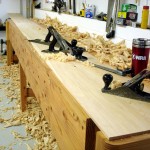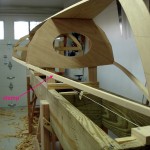The first planks to be fitted to the boat are the garboard planks, the ones at the very bottom. They are also the planks that have the most curvature in outline and in the way they lay upon the boat. They are nearly vertical at the stems and splay out to about 30 degrees in the middle of the boat.
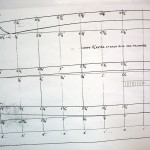 Finding their shape can be an adventure. The principle methods are two: (1) Use the shape documented in the drawings (if available), or (2) find the shape from the boat itself. The designer provided plank shapes in the drawings. Not all designers do this, but these look to be quite useful. One would imagine that using the shape from the drawings would be OK. Yet, success with that method depends on the framework being constructed as precisely as the drawings. That’s not always the case, and while my measurements appear to be right on, I don’t know how much tolerance is built into the drawings. Taking the shape from the boat itself is called “spiling” and is an art form of its own. Spiling is two parts black magic and one part semi-Euclidiean geometry. The particular variant I used is the one that Greg Rössel uses.
Finding their shape can be an adventure. The principle methods are two: (1) Use the shape documented in the drawings (if available), or (2) find the shape from the boat itself. The designer provided plank shapes in the drawings. Not all designers do this, but these look to be quite useful. One would imagine that using the shape from the drawings would be OK. Yet, success with that method depends on the framework being constructed as precisely as the drawings. That’s not always the case, and while my measurements appear to be right on, I don’t know how much tolerance is built into the drawings. Taking the shape from the boat itself is called “spiling” and is an art form of its own. Spiling is two parts black magic and one part semi-Euclidiean geometry. The particular variant I used is the one that Greg Rössel uses.
Being of the belt AND suspenders persuasion, I used both methods. It turns out that my spiled shape fits within the shape defined on the drawings. Erring on the side of cutting the plank too large, I ended up using the shape from the drawings and sawed to that shape. Sawing was easy with the bow saw. There is a “lesson learned” with the first cut. I was focusing on staying near the line and didn’t appreciate the fact that the waste piece was hanging free going “whipity whipity” as I sawed. As the cut got longer the waste piece increased it whipity whipity whipity until it went “whipity whipity CRACK.” Oooops! Hey dummy, support the material and don’t let anything whip around. Fortunately, the splitting was on the waste side of the line, not into the plank.
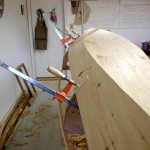 Then it came to test fitting, trimming, and repeating until the plank fit the boat well. All of the attention was for the edge of the plank that will meet the next plank up. There’s little need to fuss with the part that extends beyond the bottom, as it will be simply planed off when the time comes. Test fitting is challenging because of the extreme bends in this plank. The dry boards cannot be completely bent into place. They will need steaming to be bent to final placement. So, test fitting is “best estimate” at this stage. Set three clamps and then gingerly “muscle” the ends toward the stems. Caution is advised since this species of cedar is known to be somewhat brittle.
Then it came to test fitting, trimming, and repeating until the plank fit the boat well. All of the attention was for the edge of the plank that will meet the next plank up. There’s little need to fuss with the part that extends beyond the bottom, as it will be simply planed off when the time comes. Test fitting is challenging because of the extreme bends in this plank. The dry boards cannot be completely bent into place. They will need steaming to be bent to final placement. So, test fitting is “best estimate” at this stage. Set three clamps and then gingerly “muscle” the ends toward the stems. Caution is advised since this species of cedar is known to be somewhat brittle.
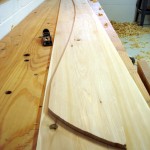 These garboard planks turn out to be quite the bananas. Here is a fitted one atop the board that will become its partner. Now we see why we need a very wide board to start with.
These garboard planks turn out to be quite the bananas. Here is a fitted one atop the board that will become its partner. Now we see why we need a very wide board to start with.
Getting the planks attached to the boat is the next adventure. That job needs screws, clinch nails, goop, big cauldrons of boiling water, towels, plastic bags, time suspension, and maybe a helper.
